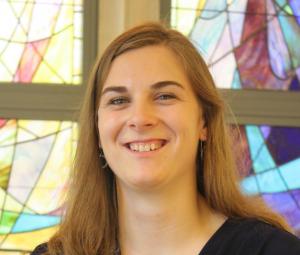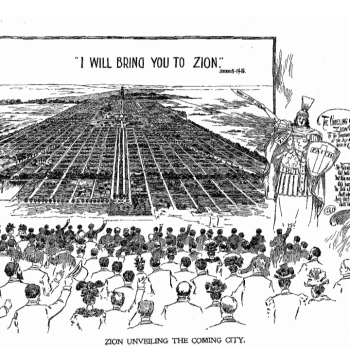 Today we welcome Regina Wenger to the Anxious Bench. Regina is a doctoral student in the Baylor History department, currently studying with Barry Hankins and Elesha Coffman. This post was born in her seminar paper for my graduate course, and I asked her to share it with our readers.
Today we welcome Regina Wenger to the Anxious Bench. Regina is a doctoral student in the Baylor History department, currently studying with Barry Hankins and Elesha Coffman. This post was born in her seminar paper for my graduate course, and I asked her to share it with our readers.
I want to share the story of two siblings: George R. Brunk II and Ruth Brunk Stoltzfus. They were a brother and a sister whose lives paralleled each other, but whose ministry opportunities differed due to their gender. George II, born in 1911, followed his father’s footsteps into the Mennonite ministry, inheriting his booming voice and theological fundamentalism. George II’s sister, Ruth, came four years later in 1915. She learned housekeeping from her mother and oratory from her father. This semester, I studied a sermon preached by each sibling on the Holy Spirit and looked for ways their presentation of the topic held clues for why they eventually came to different conclusions about women in ministry.
A professor at Eastern Mennonite College, George II decided in 1951 to join his younger brother Lawrence and crisscross the country preaching revival. Lawrence led the singing, and George II preached. Revival meetings gained popularity in the Mennonite Church early in the twentieth century, as evangelists such as J.S. Coffman and A.D. Wenger traveled to preach then-controversial “protracted meetings” at congregations across the US and Canada. The Brunk brothers also made a conscious decision to model Brunk Brothers Revivals in the style of popular evangelist Billy Graham. At a small airport just outside Harrisonburg, Virginia, in September 1952, the brothers pitched their 6,000-person tent and prepared for revival.
On one of those evenings, George II preached the sermon I studied, titled “God’s Supreme Condition of Power.” In this sermon, George II tried to show that, if listeners desired it, the Holy Spirit provided the power source to enliven and energize the believer’s faith. However, the methods he utilized to convey that message had gendered implications. Through his uses of language, illustrations, and space, George II communicated to his audience that the Spirit’s power manifested differently in men than in women—the primary difference being that it enabled men to lead and preach, a ministerial option unavailable to women. In 1952, both George II and his audience operated with the assumption that a male-only pastorate was normal. Nevertheless, George II subtly crafted this sermon to reinforce that idea.
George II eventually parted ways with Lawrence but continued to hold revivals into the 1980s. During this period, he also earned a Th.D., served as dean of Eastern Mennonite Seminary, and remained active in the publication of the Sword and Trumpet, a conservative-leaning quarterly started by his father. These platforms enabled George II to speak more broadly about the Holy Spirit. The burgeoning charismatic movement of the 1960s and 70s resonated with his theology and prompted him to edit a volume on the person and work of the Holy Spirit. While George II spent the decades following World War II garnering attention as a revivalist, educator, and theologian, Ruth cultivated her own ministry opportunities.
In 1950, a year before her brothers started their revival work, Ruth began a radio program for women titled “Heart to Heart.” It eventually went out in nineteen states on more than twenty stations and sprouted a media company—Concord Associates—that produced literature on marriage and family life. Ruth and her husband, Grant Stoltzfus, traveled across the country in the 1950s and 60s speaking on these topics. After Grant died suddenly in 1974, Ruth continued to deliver workshops solo. This platform and reputation increasingly drew her into discussions around women in ministry.
Though the early decades of the twentieth century made headway, the 1970s catapulted the topic of women in ministry to the forefront of American Protestantism. The Mennonite Church first ordained Ann Allebach in 1911; however, the issue did not gain traction until 1973 with the ordination of Emma Sommers Richards at Lombard Mennonite Church. Despite this step, the issue remained hotly contested into the early 1980s. At church-wide gatherings or in the Mennonite periodical The Gospel Herald, Ruth advocated for women in leadership. She drew upon the language of “gifts” first included in the Mennonite Church’s description of the Holy Spirit in the 1963 Confession of Faith and the emerging women’s movement. The concurrent dialogues around the Holy Spirit and women in ministry fed into Ruth’s personal experience as a public speaker. And this reputation led to an invitation from Bancroft (now Toledo) Mennonite Church to serve as their interim pastor beginning in January 1982.
Bancroft started as an urban church plant out of the rural Mennonite communities to the west in Fulton and Williams counties. Sometime during her six months at Bancroft, Ruth preached the sermon “Gifts of the Spirit…To Us.” Her role as short-term guide and preacher lent itself to practical application in personal and congregational life. With that aim in mind, Ruth assumed her audience possessed the Holy Spirit, and that what they needed was to identify and use the gifts it gave them. The Spirit, she stated, did not predispose certain types of gifts based on a person’s gender. Ruth used inclusive language when addressing her audience and stood before them as the embodiment of her message. It was pride, Ruth proclaimed, to deny a person the ability to use the gifts given to them by the Spirit just because of their gender. She knew this feeling well. It was “thrilling” to exercise one’s gifts and “killing” not to.
As the 1980s continued, the topic of women in ministry proved increasingly divisive for the Mennonite Church and the Brunk siblings. George held to the traditional position of a male-only pastorate, while Ruth advocated for women in the pulpit. He continued to combat the forces of secularization he saw in the Mennonite Church, including women in ministry. In 1984, George II joined with several other pastors to found the Fellowship of Concerned Mennonites. Meanwhile, Ruth continued to serve in pastoral mentoring and interim roles. Soon one incident personalized these differences between the Brunk siblings.
After much debate, Virginia Mennonite Conference decided to ordain Ruth in 1989. She became the first women in the conference to be credentialed. However, George II communicated to conference leadership that, if they went forward with Ruth’s ordination, he would withdraw his ministerial credentials and membership. When they did not change their decision, George II held to his commitment as well. When his sister entered the pulpit, he stepped down. Yet, though George II and Ruth never reconciled their different positions on women in ministry, they continued to relate amicably to each other for the rest of their lives.
Therein lies the biggest lesson that the Brunk siblings’ story and sermons teach us. Theological (or political) disagreements matter, but need not be toxic to relationships. There are stronger ties that bind us together. Despite not supporting her role as interim pastor at Bancroft, George II still came by Ruth’s house to help her pack her car. Ruth praised George II’s presence—in person and prayer—when her family faced a series of tragedies. And while even good sibling relationships are not perfect (just ask my sister), how George II and Ruth chose to relate to each other still proves instructive. As we spend this holiday season among family and friends with whom we might disagree, it’s helpful to remember that, though we maintain legitimate differences, there are things that matter more.













